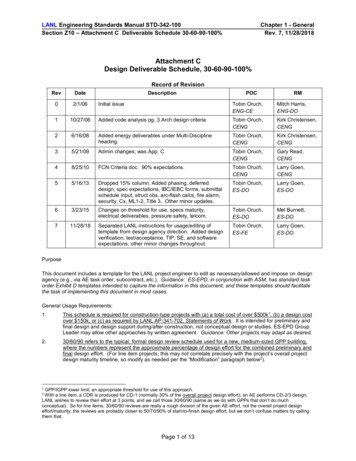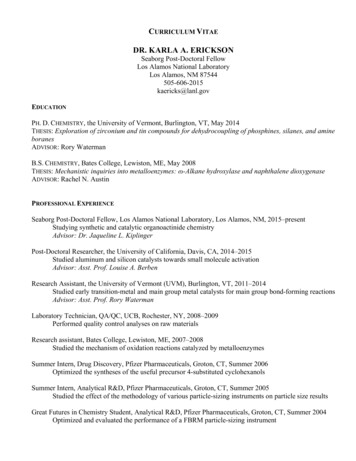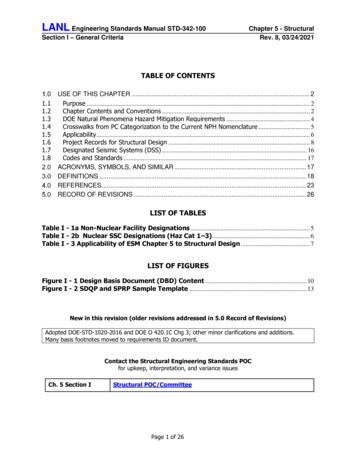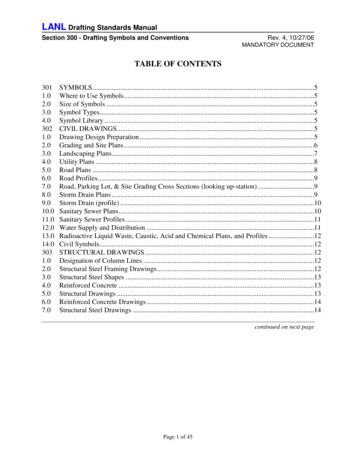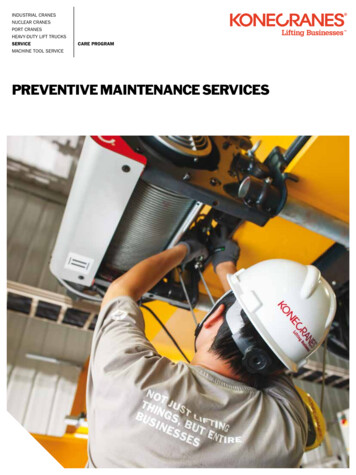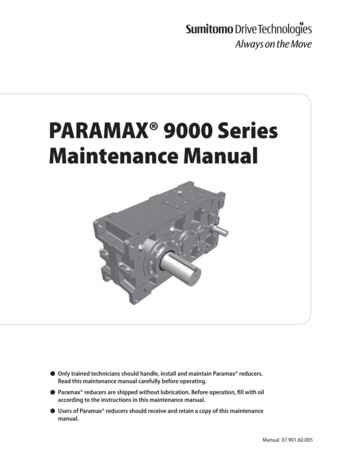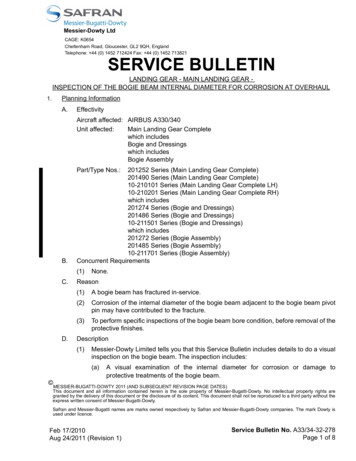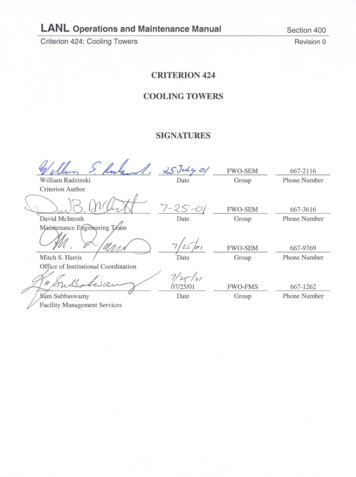
Transcription
LANL Operations and Maintenance ManualCriterion 424: Cooling TowersSection 400Date: 07/25/01Revision 0RECORD OF REVISIONSRevision No.0Date07/25/01DescriptionInitial issue. Inclusion of additional information, examples,and required statements from the approved Writers Guide,Criterion 101. Reviewed and included lessons learned from1993 to present.i
LANL Operations and Maintenance ManualCriterion 424: Cooling TowersSection 400Date: 07/25/01Revision 0TABLE OF 6.27.07.17.28.08.18.29.010.011.0PURPOSE . 1SCOPE . 1ACRONYMS AND DEFINITIONS . 1Acronyms. 1Definitions. 2RESPONSIBILITIES . 2FWO-Systems, Engineering and Maintenance (SEM) . 2Facility Manager . 2Group Leader . 2PRECAUTIONS AND LIMITATIONS. 3Precautions. 3Limitations . 3REQUIREMENTS. 4Operations Requirements. 4Maintenance Requirements. 4RECOMMENDATIONS AND GOOD PRACTICES . 5Operations Recommendations . 5Maintenance Recommendations . 5GUIDANCE. 8Operations Guidance. 8Maintenance Guidance. 8REQUIRED DOCUMENTATION . 9REFERENCES . 9APPENDICES . 10i
LANL Operations and Maintenance ManualCriterion 424: Cooling TowersSection 400Date: 07/25/01Revision 0CRITERION 424COOLING TOWERS1.0PURPOSEThis document establishes the minimum requirements and best practices for theoperation and maintenance of cooling towers at LANL facilities. This documentaddresses the requirements of LIR 230-05-01 (Ref.10.14), “Operations andMaintenance Manual.”The implementation of these requirements and recommendations satisfies DOE Order430.1A (Ref. 10.1), “Life Cycle Asset Management,” Attachment 2 “ContractorRequirements Document,” Paragraph 2, Sections A through C, which in part requireUC to “ maintain physical assets in a condition suitable for their intended purpose,”and employ “preventive, predictive, and corrective maintenance to ensure physicalasset availability for planned use and/or proper disposition.” Compliance with DOEOrder 430.1A is required by Appendix G of the UC Contract.2.0SCOPEThe LANL complex has over 50 mechanical-draft cooling towers servicinginstitutional and programmatic equipment. This Criterion addresses operations,inspections, and maintenance of all water evaporative cooling towers at LANL. Otherevaporative cooling units such as air washers, water evaporative chillers, refrigerantevaporative condensers, and air evaporative coolers will be covered under a separateCriterion. Water treatment for cooling towers is addressed in Criterion 402 (Ref.10.4), “Water Treatment of Open Cooling Units.”This Criterion does not address corrective maintenance actions required to repair orreplace equipment.3.0ACRONYMS AND DEFINITIONS3.1AcronymsCFRCode of Federal RegulationsDOEDepartment of EnergyLIGLaboratory Implementing GuidanceLIRLaboratory Implementing RequirementLPRLaboratory Performance RequirementPage 1 of 10
LANL Operations and Maintenance ManualCriterion 424: Cooling TowersSection 400Date: 07/25/01Revision 03.2LPSLightning Protection SystemO&MOperations and MaintenancePPEPersonal Protective EquipmentPP&PEPersonal Property and Programmatic EquipmentRP&IEReal Property and Installed EquipmentSSCStructures, Systems, and ComponentsUCUniversity of CaliforniaDefinitionsAttached, as Appendix A is a glossary of cooling tower terms. The use of the glossarywill aid in understanding cooling tower operations.4.0RESPONSIBILITIES4.1FWO-Systems, Engineering and Maintenance (SEM)4.1.1FWO-SEM is responsible for the technical content of this Criterion and assessing theproper implementation across the Laboratory.4.1.2FWO-SEM shall provide technical assistance to support implementation of thisCriterion.4.2Facility Manager4.2.1Responsible for operations and maintenance of institutional, or Real Property andInstalled Equipment (RP&IE) under their jurisdiction, in accordance with therequirements of this document.4.2.2Responsible for operations and maintenance of those Personal Property andProgrammatic Equipment (PP&PE) systems and equipment addressed by thisdocument that may be assigned to the FM in accordance with the FMU-specificFacility/Tenant Agreement.4.3Group Leader4.3.1Responsible for implementing operational and maintenance surveillance programsincluding the preparation and maintenance of required procedures and documentationfor PP&PE under their jurisdiction that is covered by this Criterion.Page 2 of 10
LANL Operations and Maintenance ManualCriterion 424: Cooling TowersSection 400Date: 07/25/01Revision 05.0PRECAUTIONS AND LIMITATIONS5.1PrecautionsThis section is not intended to identify all applicable precautions necessary forimplementation of this Criterion. A compilation of all applicable precautions shall becontained in the implementing procedure(s) or work control authorization documents.The following precautions are intended only to assist the author of a procedure orwork control document in the identification of hazards/precautions that may not beimmediately obvious.5.1.1Cooling tower fans are temperature controlled and can start at any time.5.1.2Coordinate all repairs that require any outage or fan lockout with all users since onetower may serve many buildings.5.1.3Cooling tower environments are wet and slippery. Use care when climbing accessladders and walking on decks. Use extreme care in winter when ice increases theslipping hazards.5.1.4Older towers may have asbestos cement siding and air intake louvers. Some may haveasbestos paper drift eliminators. See Occurrence Report ALO-LAO-LANLADO-ADMIN-1996-006, which addresses these issues.5.2LimitationsThe intent of this Criterion is to identify the minimum generic requirements andrecommendations for SSC operation and maintenance across the Laboratory. Eachuser is responsible for the identification and implementation of additional facilityspecific requirements and recommendations based on their authorization basis andunique equipment and conditions, (e.g., equipment history, manufacturer warranties,operating environment, vendor O&M requirements and guidance, etc.). Nuclearfacilities and moderate to high hazard non-nuclear facilities will typically haveadditional facility-specific requirements beyond those presented in this Criterion.Nuclear facilities shall implement the requirements of DOE Order 4330.4B (Ref.10.15) (or 10 CFR 830.340, Maintenance Management, when issued) as the minimumprogrammatic requirements for a maintenance program. Additional requirements andrecommendations for SSC operation and maintenance may be necessary to fullycomply with the current DOE Order or CFR identified above.Page 3 of 10
LANL Operations and Maintenance ManualCriterion 424: Cooling TowersSection 400Date: 07/25/01Revision 06.0REQUIREMENTSMinimum requirements that Criterion users shall follow are specified in this section.Requested variances to these requirements shall be prepared and submitted to FWOSEM in accordance with LIR 301-00-02 (Ref. 10.16), “Variances and Exceptions toLaboratory Operations Requirements,” for review and approval. The Criterion usersare responsible for analysis of operational performance and SSC replacement orrefurbishment based on this analysis. Laws, codes, contractual requirements,engineering judgement, safety matters, and operations and maintenance experiencedrive the requirements contained in this section.6.1Operations Requirements6.1.1Cooling tower related operations and water treatment must comply with NPDESPermit No. N170028335. Related requirements are contained in Criterion 402 (WaterTreatment of Open Cooling Units).Basis:NPDES Permit No. N170028335 requires proper operation andmaintenance in Section 13. (Ref. 10.8)6.2Maintenance Requirements6.2.1Cleaning operations on cooling towers with EPA-permitted outfalls must notify ESH18 at least 48 hours prior to draining basins.Basis: This is a requirement of Criterion 402, Water Treatment of Open CoolingUnits. (Ref. 10.4)6.2.2Cleaning operations on cooling towers that discharge to sanitary requires 24-hournotice to SWSC Plant Supervisor.Basis: This is a requirement of Criterion 402, ES&H, and O&M Manual for O3ACategory Outfalls. (References 10.4, 10.6)6.2.3Cooling tower solids are disposed of in accordance with LANL LIR 404-00-03 if toxicor hazardous compounds are present. Cooling tower solids free of toxic or hazardousmaterial may be disposed of in a MUNICIPAL SOLID WASTE FACILITY (LandFill). Beneficial use of cooling tower solids such as snow and ice treatment isacceptable and encouraged, provided the solids are free of toxic or hazardous material.Basis:This is a requirement of LIR 404-00-03 (Ref. 10.7), Hazardous and MixedWaste Requirements for Generators. NMED letter from Charles A. Hulesto Richard Perkins, dated June 8, 1995 (Appendix B).Page 4 of 10
LANL Operations and Maintenance ManualCriterion 424: Cooling TowersSection 400Date: 07/25/01Revision 07.0RECOMMENDATIONS AND GOOD PRACTICESThe information provided in this section is recommended based on acceptable industrypractices and should be implemented by each user based on his/her unique applicationand operating history of the subject systems/equipment.7.1Operations Recommendations7.1.1Operate cooling towers in accordance with operation instructions furnished by themanufacturer.Basis:7.1.2Cooling Towers are specific to the heat loads they are servicing per theFacility Engineering Manual and manufacturer’s specifications.Keeping a log of cooling tower measurements tracks performance and aids indetermining heat transfer problems. Measurements should include: Hot water temperatureCold water temperatureWet bulb temperatureWater FlowRangeApproachBasis:“Cooling Tower Manual,” Chapter 5, published by the Cooling TowerInstitute is an excellent source of field test measurements. (Ref. 10.11)7.2Maintenance Recommendations7.2.1Weekly7.2.1.1Cooling TowersPerform the following inspections and functional checks: Check for water leaks and broken water lines. Inspect for excessive algae growth on decks or fill. Inspect for plugged nozzles. Verify operation of blow down. Verify chemical feed pump operation. Activate mercury floats or mechanical floats to check make-up wateroperation. Check water level in basin. Check water distribution on distribution deck.Page 5 of 10
LANL Operations and Maintenance ManualCriterion 424: Cooling TowersSection 400Date: 07/25/01Revision 0 Inspect for open doors.Listen for unusual noise or vibration from fans or pumps.Inspect for oil leaking from gear drive.During freezing conditions, check for heavy ice build up on air louvers andfill.Feel fan and pump motors for over heating.Check sump screens for clogging.Basis:Criterion 402 (ref. 10.4), LANL maintenance experience and MarleyOperation and Service Manual. (Ref. 10.12)7.2.2Semi-Annually7.2.2.1Gear Reducer Box: Check oil level and fill if necessaryBasis:7.2.2.2Fan Drive Shaft Lubricate universal joints if required.Basis:7.2.2.3LANL maintenance experience and Marley Operation and ServiceManual. (Ref. 10.12)Cooling Tower PumpsBasis:7.2.2.4LANL maintenance experience and Marley Operation and ServiceManual. (Ref. 10.12)See Criterion 412 and 510. (Reference 10.4, 10.5)Cooling Tower Fans Inspect blades for build-up Observe fan for unbalance or vibration. Unbalanced fan blades can failcatastrophically.Basis:See ORPS Report SR-WSRC-CSWE-1995-0011. (Ref. 10. )7.2.3Annually7.2.3.1Gear Reducer Change oil, using manufacturer’s recommended type. Inspect oil lines and fittings for leaks. Inspect keys and keyways. Clean/replace sight glasses. Check vents.Page 6 of 10
LANL Operations and Maintenance ManualCriterion 424: Cooling TowersSection 400Date: 07/25/01Revision 0 Tighten all mounting bolts to torque specifications.Move drive shaft laterally to check for excessive play in pinion shaft.Excessive play indicates worn bearings.Basis:7.2.3.2MotorsBasis:7.2.3.3LANL maintenance experience and “Cooling Tower Technology,”Second Edition. (Ref. 10.13)See Criterion 510. (Ref. 10.5)Mechanical Coupling Check for alignment and damage. Check belts (if applicable) for damage, tension, and alignment. Lubricate pillow block bearings per Manufacturers specifications.Basis: LANL maintenance experience and “Cooling Tower Technology,” SecondEdition. (Ref. 10.13)7.2.3.4Fan Assembly With protractor, check fan blades for correct pitch (per manufacturer’sspecifications). Check fan tip to wall clearance (1 ¾ to 2 inches is recommended range). Torque hub bolts. Inspect blades for cracks or damage Check direction of fan rotation. Check/test vibration cut out switches. Clean fan blades.Basis: CTI – “Cooling Tower Manual,” Chapter 13. (Ref. 10.13)7.2.3.5Thermal Transfer Inspect fill for integrity, uniformity and unusual wear. Inspect drift eliminators for damage. Inspect nozzles for plugging and proper water distribution. Inspect air intake louvers for damage.Basis: CTI – “Cooling Tower Manual,” Chapter 13. (Ref. 10.13)Page 7 of 10
LANL Operations and Maintenance ManualCriterion 424: Cooling TowersSection 400Date: 07/25/01Revision 07.2.3.6Structural Members Inspect wood structural beams for rot and deterioration. Check connectors for tightness and corrosion. Inspect condition of handrails, ladders, and decking.Basis: CTI – “Cooling Tower Manual,” Chapter 13. (Ref. 10.13)8.0GUIDANCE8.1Operations GuidanceIt is important to know the design conditions and operational parameters of coolingtowers to operate at highest efficiencies. The operations and service manuals suppliedby manufacturers are a valuable source of this information.8.2Maintenance Guidance8.2.1JCNNM Maintenance Manual # MM44-40-004 (Ref. 10.10), “Cooling UnitMaintenance and Water Treatment Manual,” provides acceptable guidance for acooling tower maintenance program, provided it has been reviewed and approved byFWO-SEM.Page 8 of 10
LANL Operations and Maintenance ManualSection 400Criterion 424: Cooling TowersDate: 07/25/01Revision 09.0REQUIRED DOCUMENTATIONMaintenance history shall be maintained for cooling towers to include, as a minimum,the parameters listed in the Table 9-1 below:Table 9-1 Documentation ParametersMAINTENANCE HISTORY DOCUMENTATION PARAMETERSPARAMETERML 1ML 2XXRepair / AdjustmentsXXPM ActivitiesXXFailure DatesXXFailure Root CauseXXInspection DateXXSSC ConditionXXManufacturer’s Name Plate DataML 3ML 4XXMaintenance ActivitiesEquipment ProblemsInspection ResultsBasis:Documentation of the parameters listed in Table 9-1 above satisfies therequirements of LPR 230-07-00, Criteria 2, (Ref. 10.17) which states;“Maintenance activities, equipment problems, and inspection and testresults are documented.”10.0REFERENCES10.1DOE Order 0430.1A, Life Cycle Asset Management, October 1984.10.2LIR 230-04-01.0, Laboratory Maintenance Management Program, 24 April 1998.10.3LIR 230-09-00.0, Inventory and Categorization of Facilities, 19 February 1997.10.4Criterion 402, Rev. 0, Pump Systems.10.5Criterion 510, Rev. 0, Electric Motors.10.6ESH-18 Operations and Maintenance Manual for EPA Category 03A Outfalls,September 1998.10.7LIR 404-00-03, Hazardous and Mixed Waste Requirements for Generators.10.8NPDES Permit No. NM0028355.10.9LIR 404-00-04, Managing Solid Waste, 12 August 1994.Page 9 of 10
LANL Operations and Maintenance ManualCriterion 424: Cooling TowersSection 400Date: 07/25/01Revision 010.10JCNNM Maintenance Manual, MM 44-40-004, Cooling Unit Maintenance and WaterTreatment Manual.10.11Cooling Tower Manual, Cooling Tower Institute.10.12Marley Cooling Tower Fundamentals.10.13Cooling Tower Technology, Second Edition.10.14LIR 230-05-01.0, “Operations and Maintenance Manual.”10.15DOE O 4330.4B, “Maintenance Management.”10.16LIR 301-00-02.0, “Variances and Exceptions to Laboratory OperationsRequirements.”10.17LPR 230-07-00.0, “Maintenance History,” Performance Criteria 2.11.0APPENDICESAppendix A:Glossary of Cooling Tower Terms, Cooling Tower Technology,Second Edition.Appendix B:NMED letter dated 8 June 1995.Page 10 of 10
LANL Operations and Maintenance ManualCriterion 424: Cooling TowersSection 400Date: 07/25/01Revision 0APPENDIX AGLOSSARY OF COOLING TOWER TERMS
LANL Operations and Maintenance ManualCriterion 424: Cooling TowersSection 400Date: 07/25/01Revision 0GLOSSARY OF COOLING TOWER TERMSACCEPTANCE TESTINGUniform standards to determine the watercooling capability of cooling towers.Instrumentation and measurements areperformed in accordance with methodsoutlined in the Cooling Tower Institute(CTJ) Bulletin Acceptance Test Procedure(ATP) 105 or ASME PTC 1958. Testsshould be utilized to ascertain that new orrebuilt cooling towers produce DesignConditions that the Owner is paying for.Testing normally is done by third party—not the Owner or Contractor. Confidentialreport is submitted to person paying fortesting and the Owner.ACCESS TUNNELOpening in Natural Draft Tower used foraccess to the cold water basin. It can belarge enough for a man only, or largeenough for mechanical equipment.AIR FLOWTotal amount of dry air and associatedwater vapor flowing through the tower,measured at exhaust from the tower andconverted to standard air which has adensity of 0.075 lb. per cu. ft. Units:quantity, lb. per hr; velocity, fpm. Standardair (acfm) (density at DBT, WBT andpressure/ 0.075).AIR HORSEPOWERThe measure of useful power required tomove a given air rate against a givenresistance. The ratio of air horsepower tofan input horsepower is the measure of fanefficiency.AIR INLETArea of cooling tower where air is initiallyintroduced into unit by action of airflowgenerator.ALGAEA low form of plant life, which generallyrequires sunlight and air for existence.Causes plugging of heat exchanger tubesand cooling tower distribution systems.ALGAECIDEA toxic material, which will retard orprevent the growth of algae and shines.Some of the more commonly usedalgaecides are chlorine, copper sulfate andphenolic compounds.AMBIENT TEMPERATUREExternal outdoor temperature as reported byperiodic readings, also known as the drybulb temperature, measured in the regularmanner with conventional instruments.AMBIENT WET BULB TEMPERATUREWet bulb temperature of air measuredwindward of the tower and free from theinfluence of the tower. Unit: 0F. 0C.ANCHOR BOLTA threaded bolt imbedded in a concretebasin or fitted to supporting members, towhich an anchor casting is attached.ANCHOR CASTING (Column Anchor)A device for attaching the tower structure tothe foundation; it does not include theanchor bolt.Page A-1
LANL Operations and Maintenance ManualCriterion 424: Cooling TowersSection 400Date: 07/25/01Revision 0APPROACHTemperature difference in degrees betweenthe water leaving the tower and the wet bulbtemperature of the air entering the coolingtower. Performance is measured in terms ofAPPROACH. The cost of a 60F-approachtower for the same heat load would beapproximately 50% higher than a unit coolingto a 100F approach.ATMOSPHERIC TOWEROne in which air movement is dependentupon atmospheric conditions, not onmechanical fans, to force or induce airthrough the tower. The hot moist air rises inthe chimney pulling in colder outside airthrough the intake louvers.AUTOMATIC VARIABLE PITCH (AVP)Sensors and pneumatic controllers change fanblade angles to utilize minimum HPdepending upon the varying heat rejectionload required at any given time. High EnergySaver.AXIAL FLOWAir movement parallel to spinning axisgenerated by rotating fan blades.BALANCING VALVEHand or mechanically operated valveinstalled in each riser pipe of a multicelltower to permit altering the water flow tothe unit to equalize or change the volumeover each cell.BASINBottom collecting area of cold waterreturning to suction line. Crossflow towerhas additional top hot water distributionbasin and in some few cases, anintermediate hot water distribution basin islocated halfway between the top basin andthe bottom collecting basin.BASIN CURBTop level of the retaining wall of the coldwater basin; usually the datum point fromwhich tower elevation points, tower staticand total pumping heads are measured.BAYThe area between two bents or lines offraming members.BENTA line of structural framework composed ofcolumns, girts or ties; a bent mayincorporate diagonal bracing members.CENTRIFUGAL FAN causes airmovement at right angles to rotatingimpeller axis.BEVEL WASHERA metal fitting used to accommodatethrough- bolts to angular position of adiagonal member, usually connecting tocolumns or other framework members.Page A-2
LANL Operations and Maintenance ManualCriterion 424: Cooling TowersSection 400Date: 07/25/01Revision 0BLOWDOWN (Purge)CELL DIMENSIONSRemove impurities concentrated in circulating(a)Width: dimension perpendicular to towerwater due to intensification of solids by waterlongitudinal axis and usually at right anglesevaporation loss, by bleeding off a smallto the louver area; (b) Length: dimensionpercentage of the total flow.parallel to longitudinal axis and the planewhere louvers are usually placed; (c)BOARD FOOTHeight: distance from basin curb to top ofA unit of measurement of lumber representedfan deck but not including fan stack.bya board 1’ long, 12” wide, and 1” thick orNominal width and length are measuredits cubic equivalent.from and to the column centerlines. (seeNominal Tower Dimensions).BROWN ROTIn wood, decay in which the attackCELLULAR FILLconcentrates on the cellulose and associatedMost efficient fill packing developed.carbohydrates rather than on the lignin,Spreads water droplets into thin sectionsproducing a light to dark brown friablethroughout the cells of the fill therebyresidue.cooling a larger surface area for the sameenergy. A good design will have a lowerCANOPY (Natural Draft Tower)static pressure—for the same amount ofConnects the hyperbolic shell to the coolingwork performed—than wood splash barsection, acting as an air conduit and air sealpacking or steel configuration.between the two.CAPACITYAverage amount of circulating water volumein the cooling system at any given timeexpressed in terms of gallons per minute(GPM) flow.CASINGEnclosure for sidewall and endwall of acounter- flow tower and endwall of acrossflow tower exclusive of the louvers.CELLOne complete unit of a cooling towerconsisting of one distribution system,normally one set of mechanical equipmentand partition walls. Each cell can be designedto operate independently of its neighbors andreceive an equal share of the total watervolume if required for the flexibility of thesystem.Page A-3CELLULAR FILL most efficient heattransfer surfaces developed for coolingtower use.
LANL Operations and Maintenance ManualCriterion 424: Cooling TowersSection 400Date: 07/25/01Revision 0COOLING FACTORCENTRIFUGAL FANL/G (L over G)—Ratio of the pounds ofForced draft or blower wheel (also calledwater being circulated per unit time to the“squirrel cage”) causing air movement at rightpounds of dry air per unit time, which areangles to rotating impeller axis.cooling the water.CHARACTERISTICKaYIL (Crossflow) or KaV/L (Counterflow)COOLING PONDis a measurement of the order of difficulty forLarge reservoir on inexpensive real estatethe cooling tower heat rejection requirementswhereby warm water is cooled as airexclusive of the fill. The characteristic iscontacts pond’s relatively large surface arealocated on the vertical or “Y” scale, theand colder water is either reused orordinate. The value is expressed as adischarged into public waterway.dimensionless number and is usually obtainedby locating the Liquid to Gas ratio andCOOLING TOWERintersection of the approach curve. IntegrationA device for the evaporative cooling ofof the Tchebrycheff Formula will also locatewater by contact with air. This is achievedthe value on the vertical trigonometric scale.partially by an exchange of latent heatresulting from the evaporation of some ofthe circulating water, and partially byCIRCULATING WATER FLOWThe amount of hot water flowing into thetransfer of sensible heat to the air.tower. Units: quantity, lb. per hr. (one U.Sgallon 8.33 lbs.); volume, GPM; velocity,COUNTERFLOWFPS.Tower where air movement and hot watermix at 1800 counter to each other with theair moving vertically through the fillCOIL SHEDpacking and water.Portion of the tower structure housingatmospheric (tubular) heat exchangers.CROSSFLOWTower where air movement and hot waterCOLD WATER TEMPERATURE (CWT)Temperature of the water entering the coldmix at 900 or cross to each other with thewater basin before addition of make-up orair moving horizontally through the fillremoval of blowdown.packing and water.COLUMNFramework member; a main verticalsupporting member in the tower framework.CONVECTIONTransference of heat by the circulation of theheated parts of gas or liquid whereby heatedportions are lighter and rise vertically.CROSS OVER PIPING (See Header)CROSS STRUTS (Natural Draft Tower)Framework that holds up the hyperbolicshell, the number of which will varydepending on shell size.Page A-4
LANL Operations and Maintenance ManualCriterion 424: Cooling TowersSection 400Date: 07/25/01Revision 0DEW POINTCYCLES OF CONCENTRATIONThe temperature at which a given mixtureCompares dissolved solids in make-up withof air and water will have a relativesolids in the circulating water. Since chlorideshumidity of 100% saturation.are soluble, for example, cycle ofconcentration is equal to ratio of chlorides incirculating water to chlorides in make-up.DIAGONAL (Brace)Framework member; any load-bearingmember transmitting forces at other than aDECIBLEUnit of sound level measurement, gauged byright angle with reference to columns orconverting the pressure energy of noise tohorizontal ties.electrical impulses and transferring them to avoltmeter calibrated in decibels.DIFFUSION DECKA fill deck, which is located directly underthe distribution basin or nozzle bank. TheDECK STRINGERHolds the splash bars of the fill deck in apurpose of this deck is to receive water fromfixed position with respect to air and waterthe basin or nozzle and distribute itflow.uniformly over the fill decks.DELIGNIFICATION (Soft Rot)Loosening of surface fibers of softer lignitescausing weakening of timbers or splash bars,reducing members in cross-section andstrength.DISCHARGE STACKA walled enclosure extending upward abovethe eliminators to direct exhaust airvertically away from fans in a forced drafttower.DESIGN CONDITIONSThermal parameters for which the coolingtower is purchased and/or rebuilt. Expressedas cooling a given GPM flow of waterentering the tower at a specified temperature,cooling through a given range leaving thetower at the required temperature and havinga designated approach to a stated wet bulb. Acertified test (see Acceptance Testing) shouldbe incorporated in the job specifications.DISTRIBUTION BOXUsed in conjunction with the manifold andvalve assembly in a Crossflow Tower todisperse the hot water uniformly in alldirections thereby increasing theeffectiveness of the distribution nozzles.DE-SILTING SUMP (Natural Draft Tower)Area in the cold water basin, usually a lowpoint, where any silt can be flushed to a drain.DISTRIBUTION SYSTEMMechanical method of uniformly passingthe hot water over the fill area preparatoryto cooling. Low pressure spray throughpiping and nozzles is normally used incounterflow tower, and gravity drop ismainly utilized in crossflow towers.Page A-5
LANL Operations and Maintenance ManualCriterion 424: Cooling TowersSection 400Date: 07/25/01Revision 0DOUBLE-FLOW WATER COOLINGTOWERA Crossflow Tower with two fill sections andone plenum chamber which is common toboth.DOWNSPOUTA short vertically placed pipe or nozzle used ina gravity
Basis: LANL maintenance experience and Marley Operation and Service Manual. (Ref. 10.12) 7.2.2.3 Cooling Tower Pumps Basis: See Criterion 412 and 510. (Reference 10.4, 10.5) 7.2.2.4 Cooling Tower Fans Inspect blades for build-up Observe fan for unbalance or vibration. Unbalanced fan blades can fail catastrophically.
